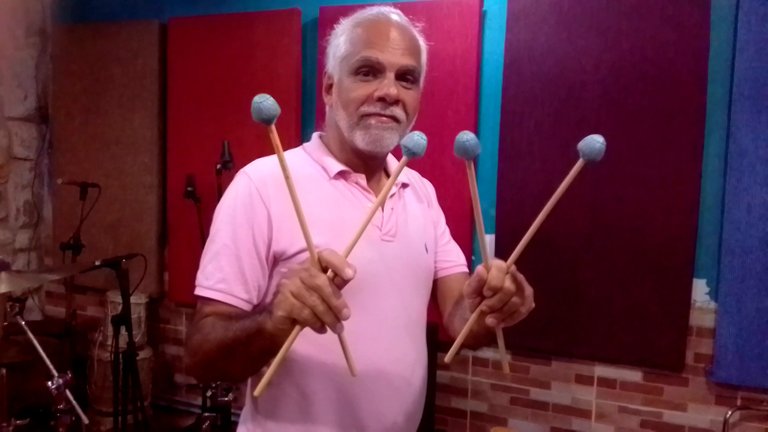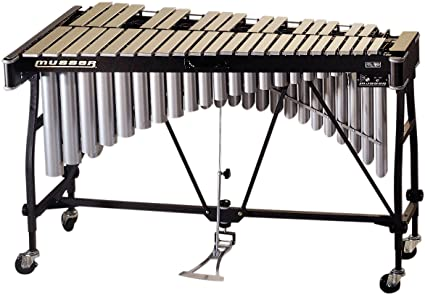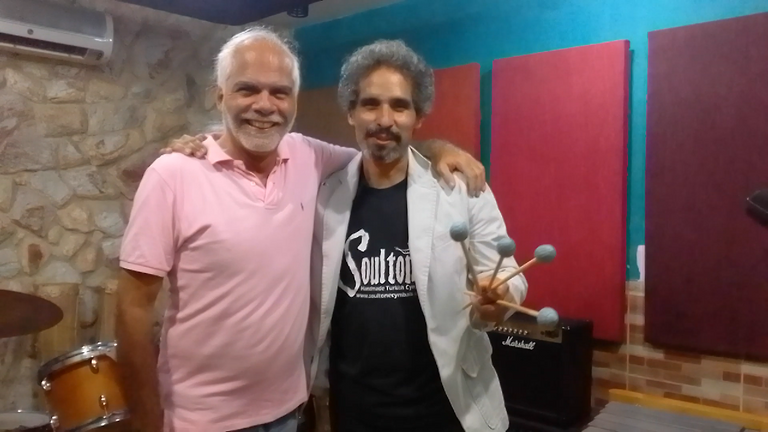Me playing Vibraphone? || ¿Yo tocando el Vibráfono?

Vibraphone || Vibráfono
So here I am attending the invitation of @mipiano, who believes that I can play all musical instruments, but the truth is that this is very, very far from reality. In reality, there are very few that I am able to play with a certain quality and many that I like, but I can't get the right sound out of them.
Among the many instruments that I like and do not play, there are the so-called Mallets, a term that actually refers to the sticks that I am showing in the picture. But these are tuned percussion instruments, that is, they can play melodies by notes. Among these, the most popular are the xylophone, the campanelli or Glockenspiel, the marimba, and the vibraphone. The first two of them are very common in classical music, the third in the traditional popular music of several countries, and the last one was born in the world of jazz. However, all of them have been used today in all musical forms.
In the first video that I attach appears, in a 1940 film, Reg Kehoe and his Marimba Queens, where they play three of these instruments, only the campanelli was missing.
Bueno, realmente la foto debía ser con el instrumento en sí y no con las baquetas, pero el ángulo de la foto no era bueno, así que, como decimos en Venezuela: ¡esto es lo que hay!.
Bien aquí estoy atendiendo la invitación de @mipiano, quien cree que yo puedo tocar todos los instrumentos musicales, pero la verdad es que eso está muy, pero muy lejos de la realidad. En realidad son muy pocos los que soy capaz de poner a sonar con cierta calidad y muchos los que me gustan, pero que no logro sacarles el sonido que corresponde.
Entre los muchos instrumentos que me gustan y que no toco, están los llamados Mallets, término que en realidad se refiere a los mazos o baquetas que estoy mostrando en la foto. Pero se trata de instrumentos de percusión afinados, es decir, que pueden tocar melodías por notas. Entre estos, los más populares son el xilófono, el campanelli o Glockenspiel, la marimba y el vibráfono. Los dos primeros de ellos muy comunes en la música clásica, el tercero en la música popular tradicional de varios países y el último nació en el mundo del jazz. Sin embargo, todos ellos se han paseado hoy en día por todas las formas musicales habidas y por haber.
En el primer video que anexo aparece, en una película de 1940, Reg Kehoe and his Marimba Queens, donde interpretan tres de estos instrumentos, allí solo faltó el campanelli.
Reg Kehoe and his Marimba Queens (vibraphones 1940s)
I have been so passionate about these instruments that, despite not being part of the traditional Venezuelan instrumentation, I included a marimba in an arrangement made for Los Cañoneros, for the song Sultana del Ávila, which we recorded in 2015.
Tanto me han apasionado estos instrumentos que, a pesar de no formar parte de la instrumentación tradicional venezolana, incluí una marimba en un arreglo hecho para Los Cañoneros, para la canción Sultana del Ávila, que grabamos en 2015.
Sultana del Ávila - Los Cañoneros
But my favorite is the vibraphone, an instrument that was born around 1927 and which should have had the name Vibraharp, but due to different confusions ended up with the name it has today.
It was an instrument that was born by and for jazz and its greatest promoters and exponents were Lionel Hampton and Gary Burton.
Pero mi preferido es el vibráfono, un instrumento que nace cerca de 1927 y el cual debía llevar el nombre Vibraharp, pero que por distintas confusiones terminó llevando el nombre qu hoy ostenta.
Fue un instrumento que nació por y para el jazz y sus máximos promotores y exponentes fueron Lionel Hampton y Gary Burton.
Lionel Hampton - Flying Home
Pat Metheny and Gary Burton - Falling Grace
There are two techniques to play it, the two mallets and the four mallets, which are taken in the way I hold them in the picture and depending on the technique varies the function of the instrument. Well, when working with only two of them, its function is melodic and it usually substitutes the wind instruments. There are arrangers who work it as if they were writing for trumpet. On the other hand, the four mallets technique brings it closer to the piano and there it fulfills harmonic and rhythmic functions.
In fact, the distribution of the aluminum plates (which is why they are also called laminophones), is like that of the piano, so it is easy to understand for pianists. But what changes radically is the execution with the mallets, which require the technique of the percussionists. I was also able to verify another interesting detail, which I will explain below.
There is a saying that is used all over Venezuela that goes: "What you did with your hands, you disrupt them with your feet". This is to indicate that a good deed you did is harmed by another bad deed. What almost nobody knows is that this is an expression that comes from the field of music and is attributed to Maestro Vicente Emilio Sojo and he used it to refer to a student of him who played very well, but handled very badly the use of the pedals of the piano, which ended up affecting the sound of his interpretation.
On the vibraphone this is much more serious, because the "muted" sound of the instrument (which is when the pedal is not pressed), is so muffled that it does not sound good. The function of this position is to mute the sound which is like a bell and it is necessary to trim it. Unlike the piano, where if you play without pressing the sustain pedal it just sounds short, here it sounds so muffled that it only serves as an occasional effect, the real beauty of the instrument is with the sustain. This makes the level of demand on the pedal much higher.
Existen dos técnicas para tocarlo, la de dos mazos y la de cuatro mazos, que se toman de la manera en que los sostengo en la foto y dependiendo de la técnica varía la función del instrumento. Pues cuando se trabaja con solo dos de ellos, su función es melódica y suele sustituir a los instrumentos de vientos. Hay arreglistas que lo trabajan como si estuvieran escribiendo para trompeta. En cambio, la técnica de cuatro mazos lo acerca es al piano y allí cumple funciones armónicas y rítmicas.
De hecho, la distribución de las láminas de aluminio (por lo cual también llevan el nombre de laminófonos), es como la del piano, por lo cual es de fácil entendimiento para los pianistas. Pero lo que cambia radicalmente es la ejecución con los mazos, que requieren la técnica de los percusionistas. Además pude comprobar otro detalle interesante, que explico a continuación.
Hay un refrán que se utiliza en toda Venezuela que dice: "Lo que hiciste con las manos, los desbarataste con los pies". Esto es para indicar que una buena acción que hiciste se ve perjudicada por otra acción mala. Lo que casi nadie sabe es que esta es un expresión que viene del campo de la música y se le atribuye al Maestro Vicente Emilio Sojo y la utilizó para referirse a una alumna suya que tocaba muy bien, pero manejaba muy mal el uso de los pedales del piano, con lo que terminaba afectando el sonido de su interpretación.
En el vibráfono esto resulta mucho más grave, porque el sonido "apagado" del instrumento (que es cuando no se pisa el pedal), es tan apagado que no suena bien. La función de esta posición es apagar el sonido que es como una campana y es necesario recortarla. A diferencia del piano, donde si tocas sin pisar el pedal de "sustain" solo se suena corta la nota, acá suena tan apagada que solo sirve como un efecto ocasional, la verdadera belleza del instrumento es con el "sustain". Esto hace que el nivel de exigencia para el pedal sea mucho mayor.

Source - Fuente
This instrument is part, nowadays, of the salsa world as well and as part of my salsa project in which I am working, I have a small group format in which I decided to include it and soon you will be able to listen to the first song I am recording.
One of the first musicians to include the vibraphone in Latin jazz was the Swedish musician Carl Tjader, in the United States, and from there other great jazzmen of those times, such as Tito Puente, began to include it.
However, the inclusion of this instrument in Latin music, or should we call it Salsa, was with Joe Cuba's sextet, starting in 1956.
Although there were many of Joe Cuba's hits, one of the most memorable for lovers of the genre is the song Mujer Divina.
Este instrumento forma parte, hoy en día, del mundo de la salsa también y como parte de mi proyecto salsero en el que estoy trabajando, tengo un formato de grupo pequeño en el que decidí incluirlo y próximamente podrán escuchar el primer tema que estoy grabando.
De los primeros en incluir el vibráfono en el jazz latino fue el músico sueco
Carl Tjader, en los Estados Unidos y de allí lo empezaron a incluir otros grandes jazzistas de esos tiempos como Tito Puente.
Sin embargo, la inclusión de este instrumento en la música latina, o ya deberíamos llamarla Salsa, fue con el sexteto de Joe Cuba, a partir de 1956.
Aunque fueron muchísimos los éxitos de Joe Cuba, uno de los que más quedaron en la memoria de los amantes del género es el tema Mujer Divina.
Mujer divina - Joe Cuba Sextet
In Venezuela there have always been many important vibraphonists linked to Latin music, but of the first groups that had great success, the group Mango stands out, where Freddy Roldán initially played. In the video I share here, Filemón Monterola, who is another of the greats, appears playing.
En Venezuela ha habido siempre muchos vibrafonistas importantes vinculados a la música latina, pero de los primeros grupos que tuvieron gran éxito destaca el grupo Mango, donde tocaba inicialmente Freddy Roldán. En el video que comparto acá, aparece tocando Filemón Monterola, que es otro de los grandes.
La música - Grupo Mango
Germán Domador is the musician who is playing with me and I took advantage of the recording we had in recent days to make this video, where I show that I definitely do not know how to play the instrument, but at least I can show how it works and as an additional gift I leave you a nice performance by Germán and a few bars of the recording of the song we are recording "Pa' los bailadores".
Germán Domador es el músico que está tocando conmigo y aproveché la grabación que tuvimos en días pasados para hacer este video, donde yo muestro que definitivamente no sé tocar el instrumento, pero al menos puedo enseñar como funciona y de regalo adicional les dejo una bonita ejecución por parte de Germán y unos escasos compases de la grabación del tema que estamos grabando "Pa' los bailadores".


A small additional gift for lovers of classical music. A sample that shows us other possibilities that this beautiful instrument has.
Un pequeño regalo adicional para los amantes de la música clásica. Una muestra que nos enseña otras posibilidades que tiene este hermoso instrumento.
Concierto para Vibráfono y Orquesta Emannuele Sejourné


Music community logo by @ikasumanera | Banner by @equipodelta


@ylich
http://ylich.com
https://sptfy.com/ylich
If you don't have an account at Hive yet, I invite you to read my post My Hive Testimony || Mi testimonio Hive
Si aún no tienes cuenta en Hive te invito a leer mi publicación My Hive Testimony || Mi testimonio Hive
▶️ 3Speak
Saludos poeta. Después de leer su clara y motivadora clase sobre el uso del vibráfono, hice copia de los enlaces de Sultana del Ávila y Mujer Divina(Una de mis preferidas). Soy un sencillo y nada musical titiritero, pero disfruto de la buena música- y de sus excelentes ejecutantes. Gracias compañero.
Nota: No pude hacer mas copias por falta de saldo en el Bam.
Jejeje, me alegra que te gustara y le sacaras partido.
No todos tenemos que ser músicos, hace falta la gente que esté sentada del otro lado para que la cosa esté completa... 😀
https://twitter.com/YlichElRuso/status/1467215839371878401
The rewards earned on this comment will go directly to the person sharing the post on Twitter as long as they are registered with @poshtoken. Sign up at https://hiveposh.com.
Siempre he dicho que ese instrumento es como una cuestión celestial, su sonido es único, suena sabroso pedaliao con rever, lo único que piyo es que debe de ser un trabajito ecualizarlo en plan de producción y eso por la resonancia y los brillitos. SALUDOS HERMANO !
Jejeje, sí. La tarea de grabarlo y mezclarlo tiene sus truquitos...! Pero vale la pena el esfuerzo porque es realmente hermoso.
Do you want to get involved? Do you want to support music and this project? Follow us to keep you updated and read our Introduction post!
🎶 Join us on our Discord Server! 🎵
How nice you picked up the invite by our own MP 🙇♂️
Four sticks to start with: 👌
Yes, I love this kind of activity, I just complain because I don't have more time to do it permanently!
Yea, TIME can be a b*tch. She is bothering me often, not allowing me to do the things I want to do.
But time never seems to run out, so plenty of opportunities to catch 😆
Hey que tal hermano.. Excelente sonido que tiene ese instrumento, no lo conocia. Pero vaya que si estas serca de mejorar con el. Una cosa, en la marimba existe una cantidad varidad de musica clasica, Ej. Danzon No 2. Les Toreadors., etc...
Pd: Me encanto ese final con el swing de salsa.. Un abrazo hermano mio, Dios te bendiga!!
Hoy en día también la marimba se ha incluido en el repertorio clásico (como casi todos los instrumentos del mundo 😅), sin embargo el que se ha usado desde hace mucho tiempo, incluyendo las piezas que mencionas, es el xilófono que aunque se parecen muchísimo, no son iguales. Pero los dos suenan igual de sabroso. 👍
¡Gracias por comentar!
Oh, @ylich, what a great post!!! I really liked your intro, es lo que hay, hahah, yeah, I think the photo with the drumsticks is a great one!! And yay, you made a video playing it, some chords, and a Mozart tune in the end, well, I congratulate you as even for that, some basic practicing and time were needed! But, your friend, Germán, well, how he plays is magic ;))
I didn't know half of the info you shared about vibraphone and the examples you shared are very nice. Loved the last share very much, the concert for vibraphone and orchestra by Emannuele Sejourné. Thank you for the follow-up, I saw your post yesterday but had a "not nice" migraine and your post needed more time to be well attended ;)
Thank you so much @mipiano! I'm happy to have participated in your challenge! ❤️
It was a double challenge 😂 started with the: a verte con el oboe 😅 y ahora se ha desarollado a iniciativa donde la gente está participando! Mi corazón lleno de alegría 😇
Gracias de nuevo, y perdón por este Spanglish comentario (espero sigo siendo the queen of comments ? ) 😅
Maybe you become the Queen of Comentarios or the Comments Reina! 😂😂😂
Real Spanglish, me gusta the first option ;D
Спасибо ;))
😅
!BEER
View or trade
BEER.Hey @mipiano, here is a little bit of
BEERfrom @ylich for you. Enjoy it!Learn how to earn FREE BEER each day by staking your
BEER.Yay! 🤗
Your content has been boosted with Ecency Points, by @ebingo.
Use Ecency daily to boost your growth on platform!
Support Ecency
Vote for new Proposal
Delegate HP and earn more
Thank you!
Clásico el sonido de Joe Cuba en el tema Mujer Divina, pienso que es un instrumento dificil de tocar. Gracias por la explicación, el instrumento suena muy bien con los Cañoneros. Un gran saludo!.
Sí, sin duda es un instrumento exigente.
¡Muchísimas gracias por tus palabras!
Conchale, Ylich, puedes tocar hasta las nubes si quieres ! xD y Germán toca maravilloso, de verdad 🤗
¡Jejeje, qué bonito comentario!
!LUV
@ylich(6/10) gave you
Que bueno verlo participar en este gran llamado realizado por mipiano. La verdad había visto este instrumento varias veces pero no tenía ni idea de como se llamaba y gracias a esta publicación he aprendido mucho. En realidad creo que son muchos los instrumentos exóticos que no conocemos y que dan sonidos que ni imaginamos. Un saludo estimado!!
Que sonido tan hipnótico ´produce ese instrumento.
Considero que tiene gran dificultad interpretativa.
Saludos Ylich!
¡Así es, amigo! También me parece que es difícil su ejecución.
¡Gracias por dejar tu comentario por acá!